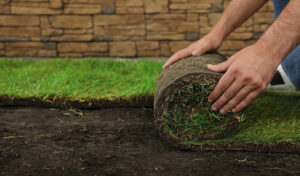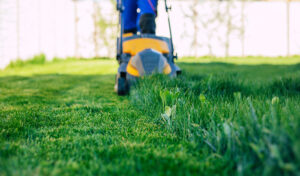Newly-laid sod takes work to get its roots established, so it’s uncommon that after installation, sod turns brown — unless there are key factors. Learn the main reasons why your new sod is turning brown and some easy, quick fixes to restore it.
Why Sod Turns Brown After Being Laid
There are four reasons why your sod may be turning brown, but keep in mind, you can’t treat new sod like you would established grass. Although laid as if it’s finished, your lawn needs extra attention for the first month or, more, so the roots can establish themselves in the soil beneath.
Not Enough Water
The key reason why lawns turn brown is that they’re thirsty. Areas where sod is wilting or turning brown, indicate that it’s not getting enough water. New sod must get plenty of water to establish its roots. Typically, you water fresh grass at least twice a day (more often if hot) for at least a week to two weeks. Water needs to soak the soil for a depth of at least ½ inch. After the first monthly, cut back watering to once or twice a week, so it moistens the soil to 1 inch of water a week.
Fed Too Soon
Unlike established grass that needs fertilizing, new sod does not for at least 30-60 days after installation. Because the root system is shallow, it won’t absorb the nutrients, so the nitrogen leaches into the soil and burns the grass; this can cause brown patches. To repair these damaged areas, water the sod to dilute the nitrogen levels in the soil, also helping to prevent browning of new growth.
No Contact
New sod needs to make good contact with the soil beneath. Air pockets can form between the roots and soil if the soil settles after installation. This means the roots aren’t able to take up water or nutrients, and the grass turns brown. Pull the sod where it’s brown and fill it beneath with new soil. Press the sod back into place firmly, so all parts have good contact with the soil. Water the area well, and once roots establish in the soil, new growth should be green.
Compacted Soil
Sod that turns brown can also be the result of compaction of the soil underneath. If this is the case, it’s because the soil is hard or compacted, which allows the water to sheet away from the sod’s roots instead of soaking into the soil. Fix the problem by pulling the browned sod up and poke holes in the soil with a screwdriver. This aerates the soil and ensures the water soaks in instead of flowing away. Press the sod back down firmly. Water the area thoroughly.
Need Help? Contact Monarch Sod
For more information on new sod installation and care, please contact us at (801) 390-5927. If you need new sod, rest assured we have high-quality, fresh blends that give you a beautiful, lush lawn. We offer fast and easy service to Utah and Salt Lake Counties, so call us today.
var /*99586587347*/











